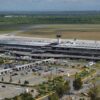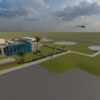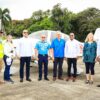 An unmanned Air Force space plane dropped out of orbit and glided to a computer-controlled California landing early Saturday to close out a classified 469-day military mission.
An unmanned Air Force space plane dropped out of orbit and glided to a computer-controlled California landing early Saturday to close out a classified 469-day military mission.
The reusable Boeing-built X-37B Orbital Test Vehicle touched down on a runway at Vandenberg Air Force Base, Calif., at 5:48 a.m. PDT (GMT-7). The Air Force did not provide any advance warning of the re-entry and landing time and no technical details about the vehicle’s performance were released.
The Air Force’s unmanned X-37B spaceplane glided to a pinpoint landing at Vandenberg Air Force Base, Calif., Saturday after 15-and-a-half months in orbit on a classified military mission.
But in a statement, the Air Force said the autonomous landing by the nation’s “newest and most advanced re-entry spacecraft” was executed “safely and successfully.”
 “With the retirement of the space shuttle fleet, the OTV program brings a singular capability to space technology development,” Air Force Lt. Col. Tom McIntyre, X-37B program manager, said in the statement. “The return capability allows the Air Force to test new technologies without the same risk commitment faced by other programs. We’re proud of the entire team’s successful efforts to bring this mission to an outstanding conclusion.”
“With the retirement of the space shuttle fleet, the OTV program brings a singular capability to space technology development,” Air Force Lt. Col. Tom McIntyre, X-37B program manager, said in the statement. “The return capability allows the Air Force to test new technologies without the same risk commitment faced by other programs. We’re proud of the entire team’s successful efforts to bring this mission to an outstanding conclusion.”
The X-37B was launched atop a United Launch Alliance Atlas 5 rocket that took off March 5, 2011, from Florida’s Cape Canaveral Air Force Station. It was the second flight for the Air Force Orbital Test Vehicle program following a successful 224-day maiden voyage in 2010. The spacecraft used for that mission is expected to be relaunched in October.
As with the initial test flight, details about the program’s just-concluded second mission are classified.
(Credit: U.S. Air Force, CNET)







